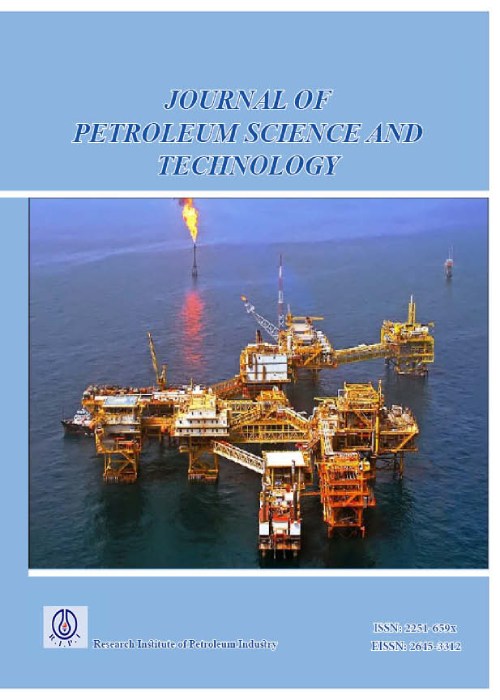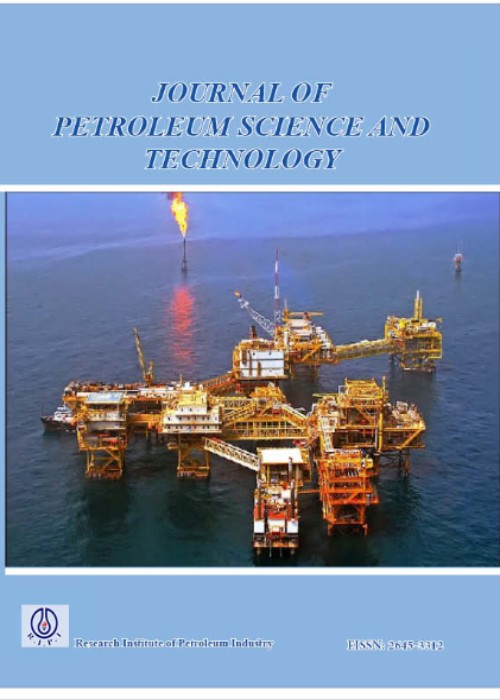فهرست مطالب

Journal of Petroleum Science and Technology
Volume:12 Issue: 4, Autumn 2022
- تاریخ انتشار: 1402/06/28
- تعداد عناوین: 6
-
-
Pages 2-12
Through stability experiments, this study investigates the stability of foams prepared using Cetyltrimethylammonium Bromide (CTAB). The aim is to examine the influence of salt type, salinity, and brine composition on foam stability. The findings reveal that salts diminish stability at intermediate and high salinities, while the brine composition also significantly affects stability. By manipulating the composition, it is possible to achieve optimal foam stability. Specifically, seawater compositions with doubled concentrations of CaCl2, Na2SO4, KCl, NaCl, and identical concentrations of MgCl2 are identified as the optimum concentrations of smart water for attaining the best foam stability, with respective half-lives of 270, 298, 262, 280, and 248 seconds. Additionally, the longevity of CTAB foams is adversely affected by oils, although the impact varies depending on the type of hydrocarbon. Generally, more polar hydrocarbons exhibit a reduced negative effect on foam stability.
Keywords: Surfactant, foam injection, stability, Enhanced Oil Recovery, Salt -
Pages 13-24A highly efficient bifunctional catalysts containing platinum-impregnated ZnO-loaded HZSM5 and its performance on direct hydrogenation of CO2 to aromatics was investigated. Methanol-mediated pathway was applied for hydrogenation reactions. ZnO was introduced to the zeolite structure through hydrothermal synthesis and illustrated gradual enhancement in surface area and pore volume of the zeolite. Pt was added to the zeolite by post treatment partial vacuum impregnation technique. The amount of zeolite acidity indicated a key role in CO2 conversion and aromatics selectivity. NH3-TPD analysis suggested that introduction of both ZnO and Pt increased the strong acid sites and conversly decreased the weak acid sites. Furthermore, some new acidic sites were appeared in zeolite structure after ZnO loading. Furthermore, XPS results proposed that most of the zinc species located on the surface of the zeolite as oxide form, whereas, the platinum is located in the catalysts in both metallic and oxide form. Increasing the amount of zinc load to 10 wt%, led to creation of some ZnO clusters that decreased the catalyst stability. However, 0.1 wt% Pt-8 wt% Zn/HZSM5 catalyst denoted as (P(8)Z/HZ5) showed the best results for CO2 conversion (88.3%) and aromatics selectivity (69.2%) with low CO selectivity (9.8%) compared to other zeolites.Keywords: ZnO, HZSM5 catalysts, Pt impregnation, CO2 hydrogenation, Aromatics
-
Pages 25-41Integrated analysis of oil traps, especially those related to facies changes, is far more complicated than reservoirs related to structural traps. The most useful way to identify these complex subsurface structures directly related to facies change is to use seismic attributes. The main goal of this study is to integrate analysis of traps and their relationship with sedimentary facies, and to achieve this goal, petrographic, petrophysical, and seismic studies were integrated. Based on petrographic studies, five petrofacies, including Micro-Conglomerate, Sandstone, Claystone/ Shale, Sandy Dolomudstone, and Sandy Dolomitic Ooid Grainstone/Hybrid, which were identified in connection with the supratidal, intertidal, lagoon and fluvial environments and the main factor controlling the reservoir quality is primary sedimentary texture. A total of 11 microfacies, including anhydrite (MF1), dolomudstone (MF2), packstone peloid/ooid (MF3), packstone oncoid/peloid (MF4), dolostone (MF5), grainstone peloid/ooid (MF6), grain stone oncoid (MF7). Microbialite (MF8), boundstone (MF9), bioclastic packstone (MF10), and mudstone (MF11) were introduced for the Mozduran formation. The facies’ matching of the Shourije Formation with seismic attributes shows that the energetic parts of the fluvial Channel are related to coarse-grained sandstone and conglomerate facies, and the fine-grained shale sediments have played the role of cap rock and caused the formation of stratigraphic traps along the fluvial Channel. The reef structures identified in the Mozduran Formation indicate two depositional environments: a carbonate shelf and a carbonate bank. Grainstone peloid/ooid, grain stone oncoid. Microbialite and boundstone facies are associated with the reef core, shoal, and lagoon and have good reservoir quality. Therefore, by using seismic attributes, it is possible to examine all types of subsurface structures and their relationship with the Stratigraphic Traps. The results showed that generalized spectral decomposition performed well for the geometric detection of buried channels and reef structures. At the same time, the instantaneous frequency indicates the unconformity boundary, and the variance attribute can effectively be employed for identifying fractures.Keywords: Kopet-Dagh, Sedimentary Facies, Oil traps, seismic attributes, Stratigraphic Traps
-
Pages 42-52TiO2 photocatalyst was used to degrade Chemical Oxygen Demand (COD) and Biochemical Oxygen Demand (BOD) from petrochemical wastewater. The photocatalytic performance of the TiO2 was studied with variations of treatment parameters such as temperature, pH, contact time, and catalyst dosage. Design of Experiment (DOE) utilizing the Taguchi method was used to find and optimize the process model. Results for photocatalytic degradation of COD and BOD indicated the proper performance of TiO2 as the photocatalyst. The best result was achieved at pH 5 after 90 min with 73% COD conversion. COD degradation of petrochemical waste was optimized according to the experimental results, while process optimization indicated best process conditions are pH ≈ 5.2, temperature ≈ 42.8 °C, catalyst dosage = 0.75, and contact time of 88 min.Keywords: TiO2 Photocatalyst, Petrochemical wastewater, COD, BOD
-
Pages 53-61Traditional mud logging cuttings identification relies on professionals to carry out visual identification and analysis based on experience. The workload is large and subject to the influence of subjectivity, which is likely to cause errors in information extraction and result analysis. Based on applying deep learning theory in image processing technology, ResNet, DenseNet, and SqeezeNet deep neural network models were built according to the classification of cuttings images. The deep neural network models were used to identify the pictures of cuttings subdivision classification. The evaluation indexes, such as stability, robustness, and recognition effect of different models, were compared and analyzed, and the three models were selected according to the best. The results showed that under the Top-2 standard, the deep neural network model was more accurate in recognizing composite cuttings images. In contrast, the SqeezeNet 1_0 model had the best performance in identifying cuttings after synthesizing different evaluation indicators. The final recognition rate of the optimized SqeezeNet 1_0 model reaches 99.48%. In addition, the obtained SqeezeNet 1_0 network model can effectively identify sandstone, mudstone, and conglomerate cuttings on-site and can be extended to the daily identification of composite cuttings.Keywords: Deep Learning, deep neural network models, image recognition, cuttings images, mud logging
-
Pages 62-69This study offers the basis and numerical application of the pressure points analysis (PPA) technique and transient model (TM) leak detection and location systems (DLS). The study numerically compared the PPA technique and the TM leak (DLS) method on a crude oil transmission pipeline. The PPA technique used pressure differentials derived from the pipeline’s upstream, midstream, and downstream pressure sensors to find and locate leaks. In contrast, the TM method used measurements of temperature, flow, and pressure at the pipeline’s inlet and outlet ends and differences in the continuity and law of conservation of momentum equations to derive equations that pilot the system to find and quantify leaks on the pipeline. The static parameters employed for both models were extracted from the pipeline (commercial steel) configuration and the Nigeria Bonny Light Crude Oil properties. The dynamics parameters applied in both models were obtained from SCADA (Supervisory Control and Data Acquisition) system. The models were used separately to detect and locate leak incidents on a straight horizontal pipeline of length 5km and diameter 0.3556m conveying Nigeria bonny light crude oil from Heritage Energy Operational Services Limited into the Trans-Forcados Pipeline (TFP). However, the Leak located by the PPA technique at 2781.2m from upstream is 30.07m after the actual Leak. In comparison, the same Leak located by the TM method is 15.10m behind the actual position, as discovered after excavation during pipeline leak remedial activities. Although both leaks (DLS)) are not accurate, the results show that the TM method is more précised regarding leak location than the PPA technique. On the other hand, the PPA technique can detect leaks faster than the TM method. Both methods are not expensive, and since they give an accurate narrow range of the section of the pipeline in which the Leak is found, they are complementary. Hence, it is recommended and advisable for an establishment to adopt both methods simultaneously for leak confirmation and to know the section of the pipeline to be excavated and replaced.Keywords: Flow, Pressure Points Analysis, Transient Model, Leak Detection, Inlet, Outlet, Scada


